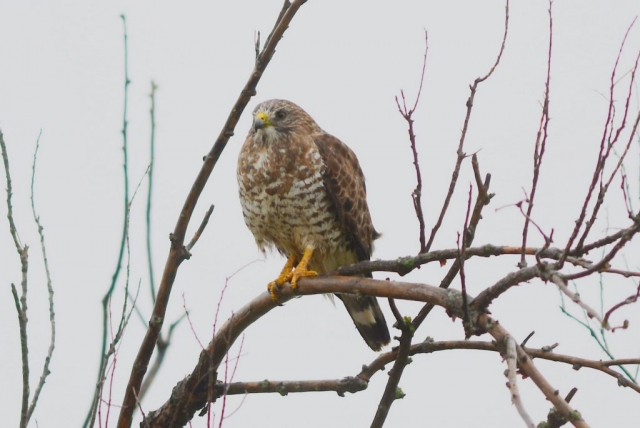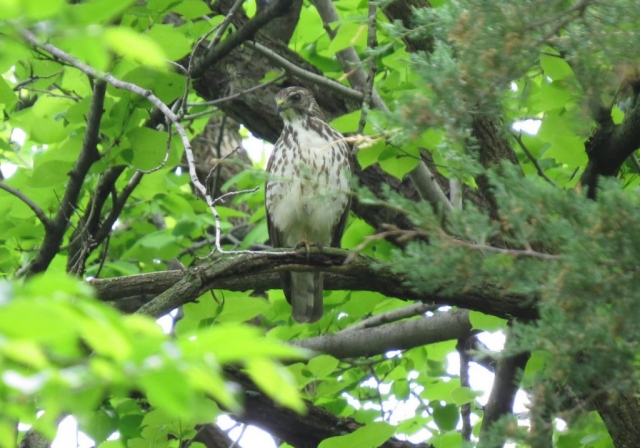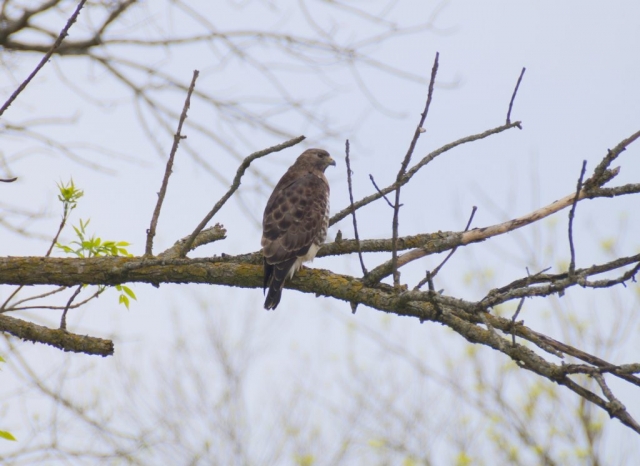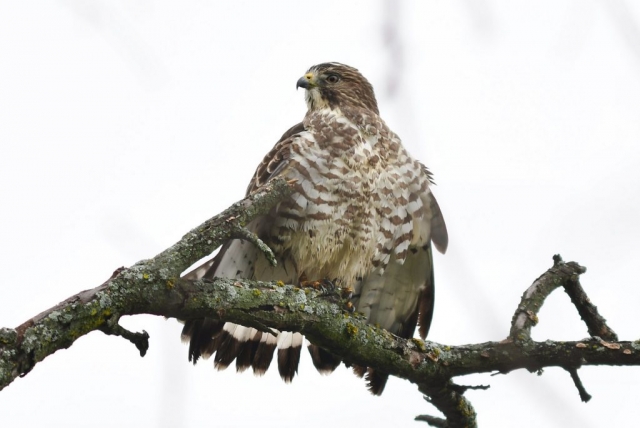Buteo platypterus PLATYPTERUS
Status: Increasing. Uncommon regular spring migrant east and central, rare west. Rare regular breeder southeast, rare casual central. Fairly common regular fall migrant east and central, rare west.
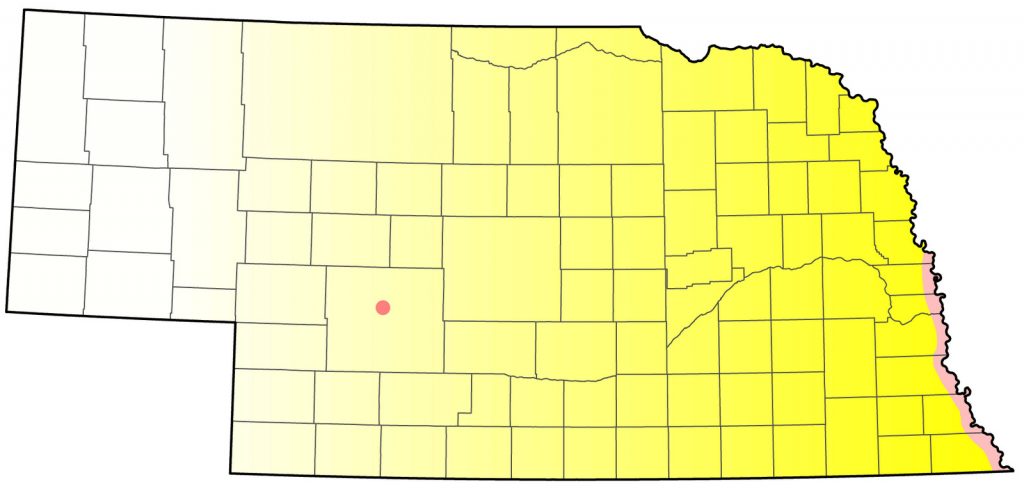
Documentation: Specimen: UNSM ZM7669, 29 Apr 1917 Lancaster Co.
Taxonomy: Six subspecies are recognized, five in the Caribbean and one, platypterus, in North America, wintering in South America (AviList 2025).
Nebraska birds are presumed platypterus.
A rare dark morph breeds in Alberta, comprising less than 1% of the overall population (Wheeler 2003); it apparently migrates through Nebraska, as there are 7-8 Nebraska reports: singles in Sarpy Co 20 Apr 2020, Jefferson Co photographed 25 Apr 2016, at Omaha, Douglas Co 29 Apr 2000, at Indian Cave SP, Richardson Co 5 May 1996, NNF Bessey, Thomas Co 29 Sep 2001, 14 May 2022 Fort Niobrara NWR, Cherry Co, and two with a kettle of 154 over Fremont, Dodge Co 24 Sep 2005.
Spring: Apr 1, 3, 3 <<<>>> Jun 1, 1, 1
Late dates above are from locations where summering birds were not reported. Numbers peak in mid- Apr and quickly drop off into May and many presumed migrants observed by mid-May are one-year-old immatures. Broad-winged Hawks generally do not breed until their second year (Goodrich et al 2020).
This species is a regular migrant in the eastern half of the state, with fewest in the west. Rosche (1982) considered it “very rare to rare” in the Panhandle, but in the 2000s reports have increased significantly. As of 2023, there were about 48 Panhandle reports in the period 16 Apr-28 May, 29 of these since 2006. There were numerous reports associated with the 2022 NOU Spring Meeting in the general area from Old Stage Hill Road east to Wright’s Gap Road in Scotts Bluff and Banner Cos, where there had been reports in previous years; eBird reports suggest at least two pairs were in the area 21-22 May. In 2024 there was a notable increase in reports; there were an amazing 19 reports (22 individuals) from 12 locations in the Panhandle, beginning with one at Wildcat Hills, Scotts Bluff Co 15 Apr. Intriguing were two as far north and west as Wayland Park, Sheridan Co 1 May 2024. In 2025 there were about nine reported from eight Panhandle locations, including at least one adult and one immature at Oliver Reservoir, Kimball Co 27 Apr-27 May.
- High counts: “hundreds” moving north along the Missouri River at Omaha 2 Apr 1978 (Williams 1978), 63 in two kettles over Wayne, Wayne Co 23 Apr 2025, 42 kettling over Branched Oak Lake, Lancaster Co 20 Apr 2023, and 23 kettling over Otoe Co 5 May 2019.
Summer: Based on a few documented breeding records and numerous breeding season reports suggestive of breeding, it is assumed this species is a regular breeder at least in the lower Missouri River Valley of Nebraska even though nesting is not known to occur regularly at any one site. Ducey (1988) cited only five records, from Douglas, Sarpy, and Nemaha Cos, the most recent in Nemaha Co in 1951 (Fox 1952) and Sarpy Co in 1979 (Williams 1979). In 1995, adults and 2-3 fledglings were heard 5 Jul at Fontenelle Forest, Sarpy Co.
More recently, as this species has expanded its range to the north and west (Goodrich et al 2020), reports of breeding in Nebraska are increasing. In 2014, a pair was nesting at the Henry Doorly Zoo in Omaha where a female was incubating 13 May; another pair was nesting in Mandan Park, Omaha 21 May, and one was collecting sticks in Bellevue 6 May although a nest was not seen. In 2015, an adult and two juveniles were at Fontenelle Forest 10 Jul, and one was at Neale Woods, Douglas Co 20-27 Jun. A juvenile was photographed at South Bend, Cass Co 30 Jul 2025.
There are consistent reports during the breeding season along and near the Missouri River; in 2016, there were reports from five locations in the southeast 14 Jun-25 Jul, in 2017 five reports from three locations 19 Jun- 27 Jul, in 2018 six reports from four locations 2 Jun- 6 Jul, and in 2023 eight reports from six locations 4 Jun-29 Jul. In 2024, 1-2 were over Indian Creek Nursery, Douglas Co from 3-30 Jun and two were over the Charles Schwab Field baseball stadium in downtown Omaha 19 Jun. Six reports of immatures in Washington, Douglas, and Sarpy Cos 31 Jul-17 Aug since 2005 may have been locally hatched juveniles (see Fall). One, possibly two, were at Ponca SP, Dixon Co 12-13 Jun 2019 and one was there 24 Jun 2025, a likely breeding location. Singles were near Crofton, Cedar Co Apr and 16 Jun 2020 and 12 Jul 2025; an adult was at this “known breeding location” 8 Jun 2021 (Brogie, Strand; eBird.org).
In concert with the range expansion by this species was the exciting discovery of a nesting pair at North Platte, Lincoln Co in 2008; three adults and at least one young eyases were present and photographed 3 Jul, but the nest was damaged by a storm by 17 Jul and the eyases could not be located. Two birds had returned to the site by 20 Apr in 2009; a nest was built but the outcome was unknown. Since 2009, adults have been in the area, with mixed success. In 2012 a pair was photographed tending a nest on 18 Jun, but on 15 Jul the two young fell out of the nest, one dying and other taken to a rehabilitator. An apparently different pair in North Platte had fledged two young by 24 Jul 2014. Since a sighting 23 Jul 2015, there have been no further reports at this site.
In 2014 a juvenile accompanied by an adult was near Wright’s Gap, Scotts Bluff Co 16 Aug; pairs have been seen in this area in previous years, but without evidence of breeding. An immature was photographed in Dawes Co 18 Jun 2019, and another immature was at Harrison, Sioux Co 4 Jun 2021. in 2025, an immature was at Fort Robinson, Dawes Co 6 Jun, and a first cycle immature was in Hitchcock Co 11 Jun.
A pair possibly nesting was at Ash Hollow SHP, Garden Co 15 May 2023, one was nearby 2 Jul 2024, and another was at Lake McConaughy 22 Jul 2024. The only other breeding season reports away from the Missouri River Valley and Lincoln Co are Jun 1970 Custer Co, 13 Jun 2014 Sioux Co, 20 Jun 1998 and 19 Jun 2017 Lancaster Co, and 7 Jul 2018 Madison Co.
In 2022 a cluster of reports in the area of Fort Niobrara NWR, Cherry Co, possibly involving only a single individual, were of four single apparent juveniles/immatures 4-8 Jun in and near Fort Falls and at the nearby Valentine Fish Hatchery; another was at nearby Merritt Reservoir, Cherry Co 7 Jun. Also in 2022, one was at Ponca SP, Dixon Co 7 Jun and an adult was in Holt Co 8 Jun.
- Breeding Phenology:
Nest building: 18 Apr-6 May
Copulation: 9 May
Eggs/incubation: 2-26 May (Mollhoff 2022)
Dependent Fledglings: 3 Jul- early Aug
Fall: Aug 15, 16, 16 <<<>>> Oct 17, 17, 19
Later dates are 22 Oct 2018 Lancaster Co, 24 Oct 2003 Saunders/Dodge Cos, 25 Oct 2018 Saunders Co, 26 Oct 2016 Lancaster Co, and 4 Nov 2024 Lancaster Co.
There is a specimen, an immature male, UNSM ZM16658, collected 22 Aug 1992 in Lancaster Co.
Hitchcock Nature Center, Pottawattamie Co, Iowa, Hawk Watch data through 2022 show an average of 788 Broad-wings passing through each year mid-Aug through mid-Oct, with a well-defined peak in late Sep (http://hawkcount.org/). Similar peak timing was observed on the Nebraska side of the Missouri River in 1994 and 1995, when 107 were counted 23 Sep 1994, 178 on 20 Sep 1995 (Loren and Babs Padelford, pers. comm.), and 50+ over Lincoln, Lancaster Co 24 Sep 2022.
Westerly reports, including those in the Panhandle, have increased markedly in recent years; of 34 Panhandle reports 11 Sep- 6 Oct, 28 are since 2000. Reports of multiple birds in the west are of overhead groups heading southeastward.
- High counts: 12,000 over Dodge Co 28 Sep 2018, 178 in Sarpy Co 20 Sep 1995, 154 over Fremont, Dodge Co 24 Sep 2005, and 107 in Sarpy Co 23 Sep 1994.
Images
Abbreviations
NNF: Nebraska National Forest
NOU: Nebraska Ornithologists’ Union
NWR: National Wildlife Refuge
SHP: State Historical Park
SP: State Park
UNSM: University of Nebraska State Museum
Acknowledgement
Photograph (top) of a Broad-winged Hawk at Holmes Lake, Lancaster Co 5 Oct 2018 by Steve Kruse.
Literature Cited
AviList Core Team, 2025. AviList: The Global Avian Checklist, v2025. https://doi.org/10.2173/avilist.v2025.
Ducey, J.E. 1988. Nebraska birds, breeding status and distribution. Simmons-Boardman Books, Omaha, Nebraska, USA.
Fox, A. 1952. Missouri River bird notes. NBR 20: 21-22.
Goodrich, L.J., S.T. Crocoll, and S.E. Senner. 2020. Broad-winged Hawk (Buteo platypterus), version 1.0. In Birds of the World (A. F. Poole, Editor). Cornell Lab of Ornithology, Ithaca, NY, USA. https://doi.org/10.2173/bow.brwhaw.01.
Mollhoff, W.J. 2022. Nest records of Nebraska birds. Nebraska Ornithologists’ Union Occasional Paper Number 9.
Rosche, R.C. 1982. Birds of northwestern Nebraska and southwestern South Dakota, an annotated checklist. Cottonwood Press, Crawford, Nebraska, USA.
Wheeler, B.K. 2003. Raptors of Western North America. Princeton University Press, New Jersey, USA.
Williams, F. 1978. Southern Great Plains Region. American Birds 32: 1024-1028.
Williams, F. 1979. Southern Great Plains Region. American Birds 33: 876-877.
Recommended Citation
Silcock, W.R., and J.G. Jorgensen. 2025. Broad-winged Hawk (Buteo platypterus). In Birds of Nebraska — Online. www.BirdsofNebraska.org
Birds of Nebraska – Online
Updated 23 Aug 2025
